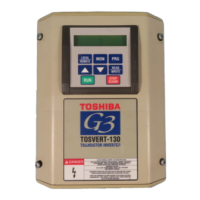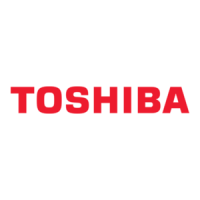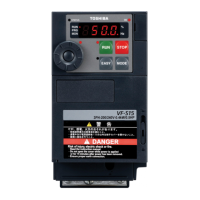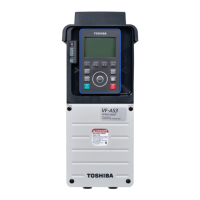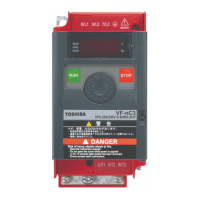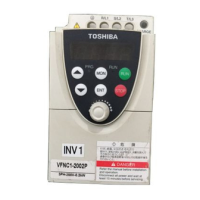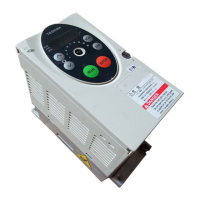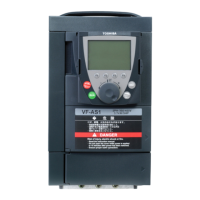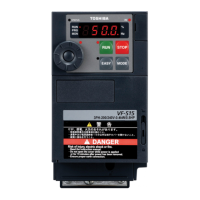TOSHIBA
Lower limit frequency 0 to upper limit frequency Hz 0 8-21
IV-ref. setting point #2 0 to 100 % 100 8-23
IV-ref. setting point #1 0 to 100 % 20 8-23
Acc/Dec #2 pattern 0: Linear 8-21
1: S-curve 0
2: C-curve
3 Upper limit frequency 0 to Max. frequency Hz 80 8-21
4 Stall protection 10 to 150 % 150 8-22
Acc/Dec #1, #2 select 0: Acc/Dec #1 0 8-21
1: Acc/Dec #2
Voltage boost 0 to 30 % 3 8-21
Auto torque boost 0: Off 0 8-21
(voltage) 1: On
6.7 First Function Parameters
Function Function Adjustment Factory Error Ref.
No. Name Display Range Unit Set Message Page
- Frequency setting 0.1~400 * Hz 0 8-6
Standard setting mode 1: 50Hz motor 3 8-21
2: 60Hz motor
0 3: Factory set (Reset to default)
(Always 0 display in this mode.)
Maximum frequency 30 to 400 Hz 80 8-21
6 - 8
1 Max. voltage frequency 25 to 400 Hz 60 8-21
V/f pattern 0: Constant torque 0 8-21
1: Variable torque
Acceleration time #1 0.1 to 6000 (SEE NOTE #1 PG. 6-9) sec 10 8-21
Deceleration time #1 0.1 to 6000 sec 10 8-21
Acc/Dec #1 pattern 0: Linear
1: S-curve 0 8-21
2: C-curve
2 Acceleration time #2 0.1 to 6000 (SEE NOTE #1 PG. 6-9) sec 10 8-21
Deceleration time #2 0.1 to 6000 sec 10 8-21
Overload detection 10 to 100 % 100 8-22
Overload detection curve 0: STD-motor, No soft stall
1: STD-motor, Soft stall 0 8-22
2: VF-motor, No soft stall
3: VF-motor, Soft stall
5 #1 output frequency 0 to Max. frequency Hz 0 8-23
#2 output frequency 0 to Max. frequency Hz 80 8-23
RR terminal priority 0: IV terminal input "on" 0 8-23
1: RR terminal input "on"
* This is the operating frequency setting parameter. It is located within the monitor
mode but is not a true first function parameter. It is used to set an operating
frequency by scrolling up or down the frequency range, using the "up" or "down"
keys until the desired frequency is reached, rather than by entering data for a
particular output frequency (see section 7.2 and 8.3).
